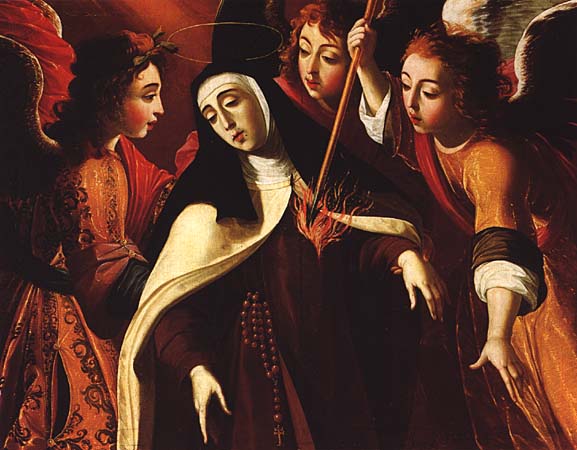
Transverberation of the heart of St Teresa of Avila
Even as a child I longed and prayed to be a saint. But somehow it always seemed to me as if that longing could never be realised, for I felt there was some kind of a barrier like a high wall between myself and God. What it was, I cannot say even now. But recently this obstacle appears to me to have been removed, the way is open, and I feel I love Jesus now as I never did before, or even hoped to. With this comes the conviction, so strong and consoling with so much peace and happiness, that Jesus will grant my heart’s desire before I die. I dare not put on paper what I feel, even if I could; but at times Jesus seems to pour all the grace of His Sacred Heart upon me, until I am intoxicated almost with His love and could cry out with the pain of that sweet wounding.
COMMENT: When Fr Doyle refers to a “sweet wounding”, is he referring to a specific mystical experience? Perhaps he is writing in a symbolic fashion, but there is a possibility that he is describing an extraordinary mystical phenomenon that we find in the lives of some of the greatest saints.
Here is an excerpt from another one of Fr Doyle’s letters in which he speaks about a kind of spiritual wounding:
What you say is indeed true. Jesus has been “hunting” me during these past days, trying to wound my heart with His arrows of love. He has been so gentle, so patient, tender, loving, I do not know at times where to turn, and yet I somehow feel that much of this grace is given me for others, I know it has helped souls and lifted them close to Jesus.
I long to get back to my little room at night, to calm and quiet, and yet I dread it, for He is often so loving there. I feel He is near because I cannot go to Him in the Tabernacle. It is such a helpless feeling to be tossed about as it were on the waves of love, to feel the ardent, burning love of His Heart, to know He asks for love, and then to realise one human heart is so tiny.
Many saints have described mystical experiences involving both spiritual delights and physical pain, especially a kind of mystical wounding of the heart. Saints such as Catherine of Siena, Therese of Lisieux, Pio of Pietrelcina and Philip Neri come to mind, including many others. The most famous of all is St Teresa of Avila, and today Carmelites celebrate the feast of the Transverberation of the Heart of St Teresa. Here is St Teresa’s description of her experience:
It was our Lord’s will that in this vision I should see the angel in this way. He was not large, but small of stature, and most beautiful—his face burning, as if he were one of the highest angels, who seem to be all of fire: they must be those whom we call cherubim. Their names they never tell me; but I see very well that there is in heaven so great a difference between one angel and another, and between these and the others, that I cannot explain it. I saw in his hand a long spear of gold, and at the iron’s point there seemed to be a little fire. He appeared to me to be thrusting it at times into my heart, and to pierce my very entrails; when he drew it out, he seemed to draw them out also, and to leave me all on fire with a great love of God. The pain was so great, that it made me moan; and yet so surpassing was the sweetness of this excessive pain, that I could not wish to be rid of it. The soul is satisfied now with nothing less than God. The pain is not bodily, but spiritual; though the body has its share in it, even a large one. It is a caressing of love so sweet which now takes place between the soul and God, that I pray God of His goodness to make him experience it who may think that I am lying.
Are Fr Doyle and St Teresa speaking of the same mystical experience, albeit using different terminology?
In the later editions of his biography, Alfred O’Rahilly included some information not found in the earlier editions. Fr Doyle gave spiritual direction to an unnamed nun who O’Rahilly described as a “privileged penitent”. By this he means that she received many graces herself from God. It seems that as well as directing her, Fr Doyle also spoke to her of his own spiritual life. This nun sent the following in a letter to O’Rahilly, presumably in an attempt to explain Fr Doyle’s “wounding”.
In response to inspirations received directly and indirectly from Jesus, he strove, notably for seven or eight years before he died, to ‘put on Jesus Christ’, to model his life on the Priest-Christ, to be, as far as it was humanly possible, ‘another Christ’. This was the secret spring of his holiness. It was not a simple attraction, not a mere fad, but a forming of a life of priestly holiness, distinctly asked for and expressed by Christ. He heard with attention the first invitation: ‘Model your life on Mine, lead a perfect life’. And as if to secure a faithful response, Jesus seemed in the year 1910 to have planted in his heart a spark of divine love. This was the ‘sweet wounding’, a grace like to that received by St Teresa, of which he complained…Jesus infused into his souls some of his own passionate love for souls; and it was this passion that made him seem to do rash things. It was the ‘charity of Christ’ that urged him, and he did nothing through mere caprice or impulse.
Such lofty heights in the spiritual life are hard for most of us to appreciate and understand. There may be extraordinary phenomena in the advanced stages of the spiritual life, and it is surely difficult for our ordinary language to explain them and even more difficult for us to begin to understand them. And perhaps, in this age of doubt and confusion, it may even sometimes be difficult to believe them.
What we can at least say about Fr Doyle is that he received many graces from God (how else could he do what he did?) and that there is evidence which suggests that some of these were very great graces. And if those great graces did actually involve a mystical wounding of his heart, then he is in good company with many of the greatest saints and mystics in the history of the Church. But we may never actually know the truth of the matter. Such a determination is of course not mine to make – it rests with the Church.
Some final, consoling thoughts for those of us who plod along as best we can: St Teresa reached incredible mystical heights despite the fact that she only truly reformed her life at 40, having even given up prayer altogether for a whole year at one stage. Special mystical experiences are not necessary for holiness; just think of the darkness that Blessed Teresa of Calcutta lived in for decades. We should have confidence that, if we continue to progress towards God, no matter what setbacks or diversions we encounter, He will continue to give us all the graces we need to reach Heaven.
